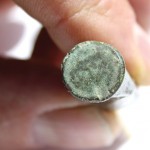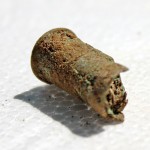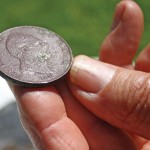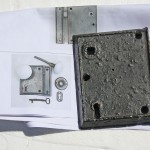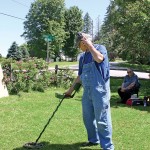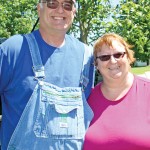SHELDON — Bill Donlon, of Enosburgh, still likes to dig in the dirt.
Why wouldn’t he, when his excavations may have turned up the first physical evidence to support eyewitness accounts of the St. Albans Raiders shooting up the Missisquoi Bank in Sheldon before heading to Canada.
“I dig up history,” said Donlon who uses a metal detector to search for buried artifacts. This summer, he’s been working at the former site of the Missisquoi Bank, where he has found four Civil War era cartridges and an old lock that was likely on the bank.
- Visible to the naked eye are a 6 and an A scratched into a Civil War-era cartridge found at the site of the former Missisquoi Bank in Sheldon. The cartridge may have been fired by one of the St. Albans Raiders.
- This rusted cartridge, bearing markings potentially from a St. Albans Raider, is awaiting cleaning and preserving.
- This British half-penny from 1831 was found at the site of the former Missisquoi Bank in Sheldon.
- This pre-1860 lock found at the site of the former Missisquoi Bank in Sheldon may have been on the bank. To the left is a drawing showing how the lock would have fit together with the doorknob.
Two of the cartridges are marked, with a 6 and A scraped into them. One of the cartridges also has the letters CSA scratched into it.
CSA likely stands for the Confederate States of America, according to Donlon. Five of the raiders were from the Kentucky Calvary Sixth Regiment, Company A.
“I can see these raiders with time to kill… just waiting to do this mission and someone decided ‘I’m going to mark my cartridges,'” said Donlon. “They’re giving you a message. These were angry men and they wanted to leave a message.”
For the raiders, waiting for the day of the raid – Oct. 19, 1864 — to arrive was likely tedious, suggested Donlon. “They didn’t have television sets. They didn’t have radio to listen to. They had to find ways to pass the time,” he said.
Twenty-two men are believed to have made their way to St. Albans from Canada and possibly points south in groups of two or three. On that Wednesday afternoon 151 years ago they robbed three banks in St. Albans, getting away with more than $200,000.
Stealing horses, they fled for Canada, pausing to try and burn a wooden bridge over Black Creek in Sheldon.
When the raiders reached Sheldon’s Missisquoi Bank, it was closed for the day, said Andy Crane, owner of the land where the bank once stood. In a letter to his son, the president of the bank described the raiders burning two barns and trying to break into the closed bank, Crane add. No one was injured in the assault on the bank.
“They did raise hell at the bank here in Sheldon,” said Crane.
The raiders did succeed in stealing a horse from Capt. Alfred Horatio Keith, who had been injured in the Civil War and sent home to recuperate, explained Crane. Keith lived across the street from the bank.
With so many witnesses, the history of the St. Albans Raid, the northernmost land action of the War Between the States, is often considered well established. “But we don’t know everything that happened,” said Crane. “The information continues to surface, literally surface.”
The raiders were widely believed to have used Navy issue pistols, but one of the cartridges Donlon found is a Henry carbine .44 caliber cartridge. It was, he explained, a metallic rim fire cartridge with an internal primer, unlike most of the cartridges of the time, which were percussion. He pointed to a white mark on the lower left side of the cartridge where it was struck by the hammer.
“They had something that was ahead of the curve,” said Donlon. “They had a Henry Carbine.”
Soldiers liked the Henry carbine rifles because they could hold 16 to 17 cartridges, explained Donlon. According to a history of the Henry repeating rifle, one Confederate soldier observed you could load the rifle on Sunday and “shoot all week long.”
The other marked cartridge is from a .22 caliber Smith and Wesson handgun.
The Missisquoi Bank was part of the commercial hub of Sheldon Springs, which also had numerous shops and hotels, a foundry and tannery. “The place was dynamic,” said Crane. “East Sheldon was just as dynamic.”
Crane and his wife, Dianne, approached Donlon asking to have him search their property last year.
Donlon also found a vertical rim lock, believed to be the lock from the bank. It’s too heavy to have been a residential lock, said Donlon, and it lacks a patent number indicating it was made before 1860. The Missisquoi Bank was founded in 1847 and the lock fits that time period.
“This could have been a lock on that building at that time,” said Donlon.
Donlon began using a metal detector, a gift from his children, to search the ground around his home four years ago. “What I found just they’re floored me, and I’ve been a junkie ever since,” he said.
His wife Cheryl has gotten drawn in, too, serving as his researcher. They couple has acquired volumes of books on coins, Civil War artifacts, and household items from the 18th and 19th centuries.
Much of what they find are ordinary items such as women’s compacts, snuffboxes, buttons and dishes, as well as plowshares, axe heads and other equipment.
At the Sheldon site, they’ve also found two British coins, an 1838 penny and an 1831 half-penny. Crane refers to them as “the last withdrawal from the Missisquoi Bank.”
Along the way, they’ve made connections at numerous museums and have gotten advice from the Lake Champlain Maritime Museum on the best way to clean their finds. It was Chris Sabick at the maritime museum who did the work to preserve the Henry carbine cartridge.
The cartridge was to be donated to the St. Albans Historical Museum this morning.
The other artifacts will eventually go to the Sheldon Historical Society, said Crane.
Digging up history
Before they begin searching for buried history, the Donlons make sure to get the permission of landowners, and any artifacts they find are given to the owners of the land after being cleaned and identified.
- Bill Donlon of Enosburgh uses a metal detector to search a Sheldon site for historic artifacts.
- Bill and Cheryl Donlon take a moment to pose for a photo while searching for artifacts in Sheldon. Bill does the searching while Cheryl researches his finds.
- Andy Crane, owner of land that once housed the Missisquoi Bank, holds a Chuck E. Cheese token dug up at the site on Saturday.
Using a more powerful metal detector then he had previously, Donlon began going over the bank site again on Saturday morning. When the detector indicates a find, he marks the spot with a small yellow flag.
He then digs around the flag, bringing up a large piece of grass, which is placed onto a piece of cardboard. With the grass out of the way, he uses a handheld detector to get into the hole.
“You never know what’s going to come out of the ground,” said Donlon. “It’s like Christmas.”
“You can dig in the dirt and you become a kid again,” he added.
After several minutes of digging and poking in the holes he had created, Donlon sat back on his heels with a small round object in his fingers.
He hands it off to Cheryl to inspect, while he carefully refills the hole and replaces the grass.
Using a dental pick and a mohair brush, Cheryl cleans the dirt from the object. On it are the words “25-cent play value” and “Pizza time theater.” It’s 1982 token from a Chuck E. Cheese.
She hands it off to Crane, who says, “This is probably the nicest thing you’ve given me today.”
Finding the token doesn’t dampen Donlon’s enthusiasm. He’s soon on his knees, making a new hole.
By MICHELLE MONROE
St. Albans Messenger Staff Writer


